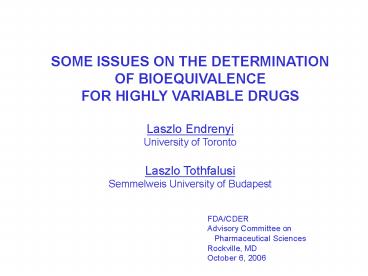SOME ISSUES ON THE DETERMINATION - PowerPoint PPT Presentation
1 / 14
Title:
SOME ISSUES ON THE DETERMINATION
Description:
1. What kinds of replicate designs should be applied? 2. Should there be a constraint on ... But: Ambivalence. Generic drug. development (including food effect) ... – PowerPoint PPT presentation
Number of Views:31
Avg rating:3.0/5.0
Title: SOME ISSUES ON THE DETERMINATION
1
SOME ISSUES ON THE DETERMINATION OF
BIOEQUIVALENCE FOR HIGHLY VARIABLE DRUGS Laszlo
Endrenyi University of Toronto Laszlo
Tothfalusi Semmelweis University of Budapest
FDA/CDER Advisory Committee on Pharmaceutical
Sciences Rockville, MD October 6, 2006
2
SYNOPSIS
1. What kinds of replicate designs should be
applied? 2. Should there be a constraint on
the estimated ratio of geometric means?
3
USUAL METHOD OF EVALUATIONUNSCALED AVERAGE
BIOEQUIVALENCE
- 1/BEL ? GMR ? BEL
- BEL BE limit - Usually 1.25
- GMR Ratio of geometric means
- - lgBEL ? log(GMR) ? lgBEL
- - lgBEL ? mT - mR ? lgBEL
- lgBEL logarithm of BEL
- mT, mR Estimated logarithmic means
4
AN APPROACH FOR HIGHLY VARIABLE DRUGSSCALED
AVERAGE BIOEQUIVALENCE
- Difference between logarithmic means is
normalized by estimated variation - - lgBELsc ? (mT - mR)/s ? lgBELsc
- A general procedure was suggested for setting BE
limits (BELsc) - Advantages
- - Statistical power is independent of variation
- - Statistical power is, with same sample size,
much higher than of unscaled average BE - - Interpretation Compare expected change due to
switching with expected difference between
replicate administrations - - Interpretation Standardized effect size, as in
clinical comparisons
5
REPLICATE STUDY DESIGNS FORAPPLYING SCALED
AVERAGE BIOEQUIVALENCE
- Difference between logarithmic means is
normalized by estimated variation - - lgBELsc ? (mT - mR)/s ? lgBELsc
- s Often regarded as within-subject variation of
reference product (sWR) - For estimating sWR a single-sequence 3 period
design could be sufficient - RRT
6
REPLICATE STUDY DESIGNS FORAPPLYING SCALED
AVERAGE BIOEQUIVALENCE
- An additional goal
- To compare variations of the two drug products
- sWT/sWR
- Could identify highly variable drug products
- Replications of both RR and TT are required
- For example
- RRT
- TTR
7
REPLICATE STUDY DESIGNS FORAPPLYING SCALED
AVERAGE BIOEQUIVALENCE
- Refine the additional goal
- To compare variations of the two drug products
- sWT/sWR
- within the same subject
- More effective identification of highly-variable
drug products - Also can identify (some) outlying observations
- Example of study design
- RTRT
- TRTR
8
REPLICATE STUDY DESIGNS FORAPPLYING SCALED
AVERAGE BIOEQUIVALENCE
- NOTE
- 3- and 4-period designs require approximately
the same number of observations
9
SHOULD THERE BE A CONSTRAINT ON GMR?
- Concern about possibly large deviations between
estimated logarithmic means - i.e., about log(GMR)
- L. Benet, AAPS Workshop on Individual BE,
1999. - Concern about interpretation to physicians
10
SHOULD THERE BE A CONSTRAINT ON GMR?
- Larger deviation between the (logarithmic) means
arises as a natural, direct consequence of the
higher variability
Larger deviations occur at higher
variations They would be truncated by GMR
constraint Moreover
11
QUALITY CONTROL ORTHERAPEUTIC SURROGATE?
BioInternational 1994 Both! But Ambivalence
- QUALITY CONTROL THERAP. SURROGATE
- HIGH SENSITIVITY CLINICAL RELEVANCE
- HIGH STATISTICAL POWER
- Young, healthy (male) volunteers
Heterogeneous study popul'n - Single dosing Steady state
- Cmax/AUC Cmax
- Parent drug Active metabolite
- Recommendations of FDA
- Does one guidance/method satisfy both goals?
12
(No Transcript)
13
SHOULD THERE BE A CONSTRAINT ON GMR?
- Possible concern about large estimated GMR may
possibly apply to the introduction of generic
products, - but NOT during the development of new drugs.
- Therefore a secondary regulatory criterion
should NOT be generally invoked
14
CONCLUSIONS
- 3- or preferably 4-period study designs in which
both the - reference and test products are replicated
(RR and TT), enable the comparison of
within-subject variations and the identification
of highly-variable drug products. - A constraint of the estimated ratio of geometric
means is - not warranted scientifically or, generally, for
the sake - of public relations.































